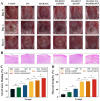Multifunctional polysaccharide composited microneedle for oral ulcers healing
- PMID: 37706204
- PMCID: PMC10495667
- DOI: 10.1016/j.mtbio.2023.100782
Multifunctional polysaccharide composited microneedle for oral ulcers healing
Abstract
Oral ulcers have periodicity and recurrence, and the etiology and causative mechanisms remain unclear; therefore, it is difficult to treat oral ulcers effectively. Current clinical treatment methods mainly include pain relief and administration of anti-inflammatories to prevent secondary infections and a prolonged recurrence cycle. However, these traditional treatment methods are administered independently and are susceptible to muscle movements and constant salivary secretion in the mouth, resulting in ineffective drug functioning. Therefore, development of a novel treatment to reduce wound infection and accelerate wound healing for oral ulcers is required for effective treatment. Herein, we report a multifunctional polysaccharide composite microneedle patch based on hyaluronic acid (HA) and hydroxypropyl trimethyl ammonium chloride chitosan (HACC) loaded with dexamethasone (DXMS) and basic fibroblast growth factor (bFGF) for oral ulcer healing. DXMS and bFGF encapsulated the HA tip portion of the microneedle patch, endowing the microneedle patches with anti-inflammatory and angiogenic properties. HACC was applied to the back of the microneedle patch, adding antibacterial properties. The experimental results indicated that the prepared dressings exhibited good antibacterial activity and effectively promoted cell migration growth and angiogenesis. More importantly, animal experiments have shown that multifunctional microneedle patches can effectively promote oral ulcer healing. Thus, these novel multifunctional polysaccharide composite microneedle patches have great potential for oral ulcers treatment.
Keywords: Hyaluronic acid; Microneedle; Oral ulcers; Polysaccharide; Wound healing.
© 2023 The Authors.
Conflict of interest statement
The authors declare that they have no known competing financial interests or personal relationships that could have appeared to influence the work reported in this paper.
Figures










Similar articles
-
Multifunctional hyaluronic acid/gelatin methacryloyl core-shell microneedle for comprehensively treating oral mucosal ulcers.Int J Biol Macromol. 2024 May;266(Pt 1):131221. doi: 10.1016/j.ijbiomac.2024.131221. Epub 2024 Mar 28. Int J Biol Macromol. 2024. PMID: 38554926
-
Combination therapy using multifunctional dissolvable hyaluronic acid microneedles for oral ulcers.Int J Biol Macromol. 2023 Nov 1;251:126333. doi: 10.1016/j.ijbiomac.2023.126333. Epub 2023 Aug 14. Int J Biol Macromol. 2023. PMID: 37586633
-
A biphasic drug-releasing microneedle with ROS scavenging and angiogenesis for the treatment of diabetic ulcers.Acta Biomater. 2024 Oct 1:S1742-7061(24)00572-5. doi: 10.1016/j.actbio.2024.09.045. Online ahead of print. Acta Biomater. 2024. PMID: 39362454
-
Smart microneedle patches for wound healing and management.J Mater Chem B. 2023 Mar 30;11(13):2830-2851. doi: 10.1039/d2tb02596e. J Mater Chem B. 2023. PMID: 36916631 Review.
-
Chitosan, alginate, hyaluronic acid and other novel multifunctional hydrogel dressings for wound healing: A review.Int J Biol Macromol. 2023 Jun 15;240:124321. doi: 10.1016/j.ijbiomac.2023.124321. Epub 2023 Apr 4. Int J Biol Macromol. 2023. PMID: 37019198 Review.
Cited by
-
Recent Developments in Using Microneedle Patch Technology as a More Efficient Drug Delivery System for Treating Skin Photoaging.Clin Cosmet Investig Dermatol. 2024 Oct 31;17:2417-2426. doi: 10.2147/CCID.S492774. eCollection 2024. Clin Cosmet Investig Dermatol. 2024. PMID: 39498279 Free PMC article. Review.
-
Research Progress of Hydrogel Microneedles in Wound Management.ACS Biomater Sci Eng. 2024 Aug 12;10(8):4771-4790. doi: 10.1021/acsbiomaterials.4c00972. Epub 2024 Jul 10. ACS Biomater Sci Eng. 2024. PMID: 38982708 Free PMC article. Review.
-
Microneedles Based on a Biodegradable Polymer-Hyaluronic Acid.Polymers (Basel). 2024 May 14;16(10):1396. doi: 10.3390/polym16101396. Polymers (Basel). 2024. PMID: 38794589 Free PMC article. Review.
-
Research Progress on New Functions of Animal and Plant Proteins.Foods. 2024 Apr 17;13(8):1223. doi: 10.3390/foods13081223. Foods. 2024. PMID: 38672894 Free PMC article. Review.
-
Unravelling the role of microneedles in drug delivery: Principle, perspectives, and practices.Drug Deliv Transl Res. 2024 Jun;14(6):1393-1431. doi: 10.1007/s13346-023-01475-9. Epub 2023 Nov 30. Drug Deliv Transl Res. 2024. PMID: 38036849 Review.
References
-
- Toche P., Salinas L., Guzmán M.M., Afani S., Jadue A. Recurrent oral ulcer: clinical characteristic and differential diagnosis. Rev. Chil. infectol.: Organo Oficial de la Sociedad Chilena de Infectologia. 2007;24:215–219. - PubMed
-
- Thakrar P., Chaudhry S.I. Oral ulceration: an overview of diagnosis and management. Prim. Dent. J. 2016;5:30–33. - PubMed
LinkOut - more resources
Full Text Sources

